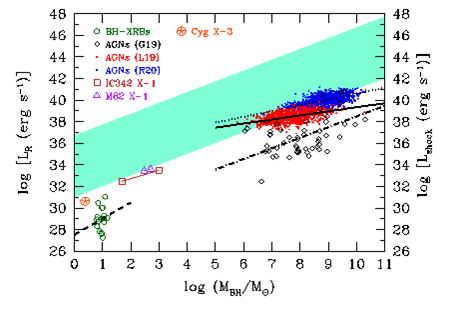A new study has the potential to explain the origin of the core radio emission from a variety of black hole sources which has so far remained a mystery.
Black holes are the exotic objects that are powered by the accretion of matter from the surroundings at extremely high velocities. In reality, nothing, including light, can avoid the fatal attraction of a black hole due to its super strong gravity. Black holes of different masses can be found in the Universe, ranging from a few solar masses in Black Hole X-ray Binaries (BH-XRBs) to a few billion solar masses in Active Galactic Nuclei (AGNs). A fraction of these astrophysical objects emit powerful radio emission from the center. However, the origin of this core radio emission is still unclear. Several sources of core radio emissions have previously been proposed to power the jets in astrophysical sources like the rotational energy of black holes.
An team of Indian Astrophysicists, including one from the Aryabhatta Research Institute of observational sciences (ARIES), Nainital (an autonomous institute of DST, Govt. of India) have carried out a new study which has potential to explain the origin of the core radio emission from a variety of black hole sources.
They have found that the energy from the accretion disk rather than the spin of the black hole can power the jet suggesting that the jet possibly launched from the accretion disk.
They observed shock-induced accretion solutions which are commonly obtained for a wide range of the flow parameters, such as energy and angular momentum, around certain black holes. When the shock is dissipative in nature, a part of the accretion energy is released through the upper and lower surfaces of the disc at the location where the shock transition (discontinuous transition of supersonic accretion flow to subsonic regime via shock) takes place.
The team looked at very high speed accretion flow involving dissipative shocks and found that that the maximum accretion energies that can be extracted at the dissipative accretion shock are around 1% and around 4.4% for non-rotating or static black hole with no charge (Schwarzschild black holes) and rotating black hole with no charge (Kerr black holes) respectively.
Accordingly, the loss of kinetic power (or shock luminosity, Lshock) was estimated and further compared with the observed core radio luminosity (LR) of black hole sources for a wide mass range. This dissipative shock model is potentially viable to account for the radio luminosity of a wide range of astrophysical objects. The model is tested on a sample consisting of 16 black hole X-ray Binaries (BH-XRBs), 2 intermediate-mass black holes (IMBHs) sources and 2176 active galactic nucleus (AGNs).
This research is led by Santabrata Das (IIT Guwahati) and Anuj Nandi (URSC), in collaboration with C. S. Stalin (IIA), Suvendu Rakshit (ARIES), I. K. Dihingia (IIT Indore), Swapnil Singh (URSC), Ramik Aktar (Xiamen University, China), and Samik Mitra (IIT Guwahati). This work has recently been published in the journal Monthly Notices of the Royal Astronomical Society (MNRAS).
Publication link:
DOI: https://doi.org/10.1093/mnras/stac1398
For more details, please email Dr. Suvendu Rakshit on suvendu[at]aries.res.in

Figure: Comparison of kinetic power Lshock with the observed core radio emission (LR) of BH-XRBs and AGNs source samples. Shaded region represents the model estimate of Lshock. Open circles denote BH-XRBs, whereas open diamonds, red dots and blue dots represent the AGN samples, respectively. Open squares and open triangles are for IMBH sources. Solid, dotted, dot-dashed and dashed lines indicate liner regression results for AGNs (L19), AGNs (R20), AGNs (G19), and BH-XRBs, respectively.






























